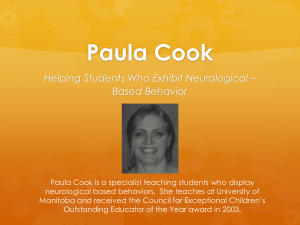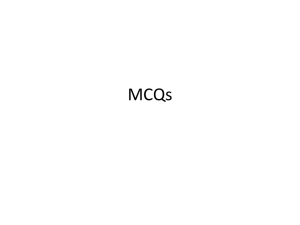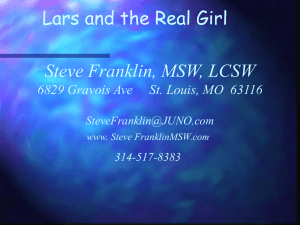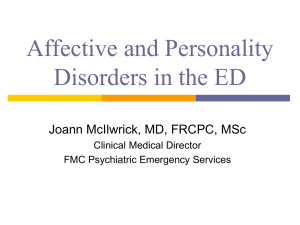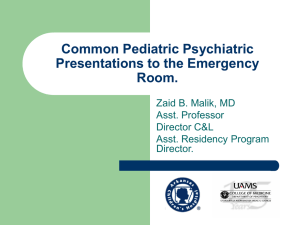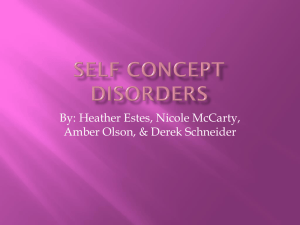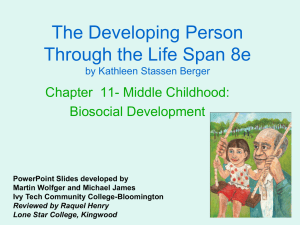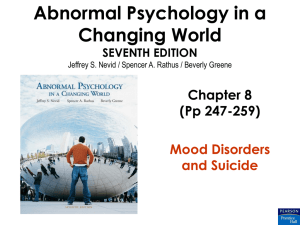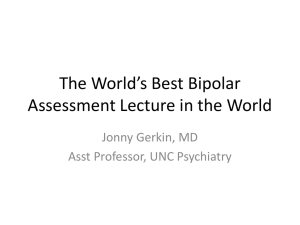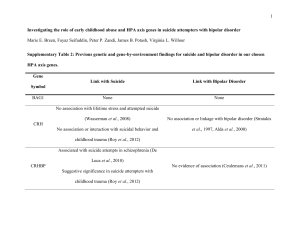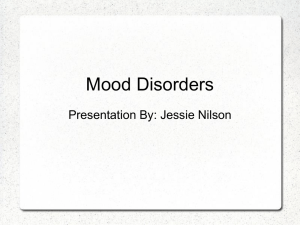職場心理衛生
advertisement
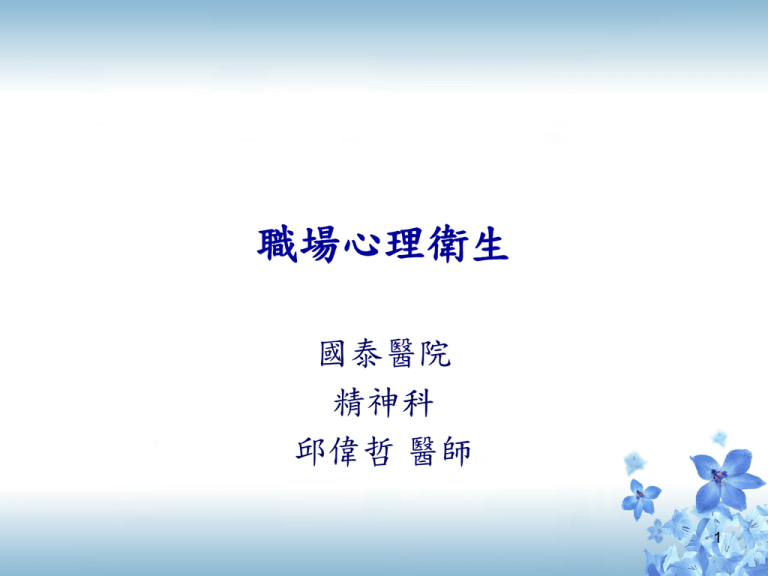
職場心理衛生 國泰醫院 精神科 邱偉哲 醫師 1 課程大綱 Mental Illness 分類 壓力與職場常見壓力 與職場相關之精神疾病 直接壓力相關 間接壓力相關 自殺 2 Mental Illness 分類 Organic or Substance related Psychosis(精神病) Schizophrenia, bipolar disorder, major depressive disorder, delusional disorder Neurosis(精神官能症) Anxiety disorder, panic disorder, OCD, PTSD, Adjustment disorder Psychosis 與 Neurosis主要分別在現實感 3 Stress 壓力的特性 失掉控制力 不可預期性 失去發洩管道 壓力源包括下列五者: (一)環境壓力源 (二)災變事件 (三)生活改變 (四)日常瑣事 (五)心理因素 4 壓力不解除會如何? 壓力源(短期,長期) 耗竭 體質或基因的脆弱性 精神疾病 5 職場上常見壓力 急性 面臨或目睹重大傷害 工作失敗 工作量增加 強迫退休 降職 升職 調派 性騷擾 與同事糾紛 慢性 長時間工作 長期睡眠剝奪 輪班 6 輪班制度注意事項 順時針方向的輪班方式較易調適。 換班頻率不宜過快。 早班交接時間不宜太早。 剛換班時可以容許彈性工時。 光照療法 曝曬於照明度達7000-30000燭光的強光下一小時。 可有效調整約日節奏。 下班後應避免其他光源的曝曬 7 Mental Illness related to the Stress Adjustment disorder Acute stress disorder PTSD 8 Adjustment Disorder Maladaptive reaction within three months of onset of stressor/s Distress in excess of normal reaction Not manifestation of personality disorder Symptoms resolve within 6 months of termination of stressor Acute versus Chronic 9 Adjustment Disorder Coded Symtom Subtype With Depressed Mood With Anxiety With Anxiety and Depressed Mood With Disturbance of Conduct With Mixed Disturbance of Emotions and Conduct Unspecified 10 Acute Stress Disorder New to DSM-IV (1994) Symptoms 2 days to 4 weeks following traumatic event 11 PTSD的定義 依DSM-IV 1993的定義如下: 一個人經歷極度的創傷壓力事件而且出現害 怕、無助感、或恐怖感的反應;這樣的壓力事 件如戰爭經驗、天災及強暴;隨後表現下列三 大類症狀: 此創傷壓力事件經由夢境或回憶持續被再體驗 對創傷相關的刺激產生逃避及對一般反應麻木 持續升高警覺性 若以上的症狀造成人際社會功能受損,而且持 續一個月以上,則稱為PTSD。 12 Symptoms Categories (PTSD) Intrusive distressing recollections dreams flashbacks psychological trigger reactions physiological trigger reactions 13 Symptoms Categories (PTSD) Avoidance avoid thoughts, feelings or discussions avoid activities, places memory blocks anhedonia (without pleasure) numb alexithymia (emotions unknown) feeling of doom 14 Symptom Categories (PTSD) Hyperarousal Symptoms sleep disturbance anger problems concentration startle response “on guard” hypervigilence 15 PTSD的流行病學 以急性壓力症(ASD),及PTSD為主(兩者之 區別為症狀之出現及持續時間,ASD為兩 天以上,一個月以下,而PTSD為一個月以 上) 在各種創傷後發生PTSD的機率為5-75%, 而在數年後的盛行率通常小於10% 16 PTSD的病因 Stressor:並不一定要現場經歷,一般是指下述 任何一種情境 直接經驗到真實的或具威脅性的死亡、 嚴重傷害、 或對自己 或他人身體的完整性造成威脅 目睹關於死亡、 受傷、 或對他人身體完整性產生威脅 知悉關於不可預期或暴力性的死亡、 嚴重的傷害、 或親近的 人感受到死亡或傷害的威脅 Biological factors: Sympathetic activity:sympathetic tone Neuroendocrine functions:hypothalamo-pituitaryadrenal axis dysfunction 17 DSM-IV Diagnostic Criteria for Panic Attack A discrete period of intense fear or discomfort, in which four (or more) of the following symptoms developed abruptly and reached a peak within 10 minutes: Palpitations, pounding heart, or accelerated heart rate Sweating Trembling or shaking Sensations of shortness of breath or smothering Feeling of choking Chest pain or discomfort Nausea or abdominal distress Feeling dizzy, unsteady, lightheaded, or faint Derealization (feelings of unreality) or depersonalization (being detached from oneself) Fear of losing control or going crazy Fear of dying Paresthesias (numbness or tingling sensations) Chills or hot flashes 18 Panic Disorder Recurrent, unexpected panic attacks Persistent concern Preoccupation with having another attack Worry about consequences of attack Significant behaviour change in response to attacks 19 Panic Disorder Often accompanied by avoidance behaviours (agoraphobia) Onset around late adolescence, early adulthood More women than men High rates of service utilization, poor quality of life 20 Specific Phobia – Diagnostic features Types –marked and persistent fear and avoidance of specific stimulus Situation interfere significantly with person’s life Excessive or unrealistic ANS arousal 21 Phobia - subtype animal environmental blood, injury, injection specific situation – elevators, flying other 22 Specific phobia Prevalence rates from 7-11% Often emerge during adolescence, usually earlier than age 25 Tend to be chronic, but may fluctuate over life course Self-report Conditioning theories or systematic desensitization 23 Major Depressive Disorder 24 DSM-IV-TR Diagnostic Criteria for Major Depressive Disorder ≥5 of the following have been present during the same 2-week period and are a change from previous function Depressed mood Decreased interest in pleasure Significant weight loss or gain (>5% in 1 month) Hypersomnia or insomnia Fatigue or loss of energy Psychomotor agitation or retardation Feelings of worthlessness or excessive/inappropriate guilt Diminished ability to think or concentrate Recurrent thoughts of death or suicidal ideation At least one of the symptoms is depressed mood or loss in interest or pleasure American Psychiatric Association. Diagnostic and Statistical Manual of Mental Disorders, Fourth Edition, Text Revision. Washington, DC: American Psychiatric Association; 2000. 25 Disease Course of Major Depressive Disorder (MDD) Remission “Normalcy” Recovery Response Symptoms Syndrome Relapse Treatment phases Acute Continuation Recurrence Maintenance 26 Adapted from Kupfer DJ. J Clin Psychiatry. 1991;52(suppl 5):28-34. Bipolar Disorder Bipolar I – Depression & Mania At least one Manic episode Bipolar II – Depression & hypomania At least one hypomanic eipsode 27 Dx for Manic Episodes (DSM-VI) A. Duration more than 1 week (期間大於一星期) B. Three (or more) of the following symptoms : 下列症狀大於 3 項或以上: (1) inflated self-esteem or grandiosity 自信心增高 (2) decreased need for sleep 睡眠需求減少 (3) more talkative than usual or pressure to keep talking 多話 (4) flight of ideas or subjective racing thoughts 跳躍性思考 (5) distractibility 易分心 (6) increase in goal-directed activity or psychomotor agitation 增加目的性行為或激躁不安 (7) excessive involvement in pleasurable activities that have a high potential for painful consequences 增加享樂性行為 28 Dx for Manic Episodes (DSM-VI) C. Do not meet criteria for a mixed episode. D. Cause marked impairment in occupational functioning or in usual social activities or relationships with others, or to necessitate hospitalization to prevent harm to self or others, or there are psychotic features. E. Not due to the direct physiological effects of a substance or a general medical condition (e.g., hyperthyroidism). 29 PSYCHOTIC FEATURES PSYCHOTIC FEATURES 30 Suicide Suicidal ideation Suicidal threatening Suicidal behavior Commit Suicide 31 Suicide, suicide attempt and mood disorder Mood disorder Suicide attempt 15%suicide 10% suicide within 10 years Suicide 45-70% with mood disorder 19-24% had previous suicide history 32 精神疾病與自殺 大部分(97%)自殺者生前罹患精神疾病 重鬱症(89%) 物質濫用(酒癮)(45%) 情緒不穩之性格障礙 (為前三名之精神疾病) 憂鬱症合併物質濫用是最常見的共病狀態 超過90%的自殺者生前罹患憂鬱症 33 (鄭泰安,1995) 自殺的危險因子 失落的生活事件 一等親有自殺行為 重鬱症 情緒不穩人格障礙 (鄭泰安,2000) 34 過勞與自殺 工作型態有關:臺灣人和日本人常像是工蜂一樣 整日勞碌 相關疾病 憂鬱症 耗竭症候群(burn out syndrome) 慢性疲勞症候群 檢測量表 簡易壓力量表網路版 勞研所 勞工職業壓力量表 職場疲勞量表 台大衛生政策與管理研究所鄭雅文老 師 羅士翔2007 35 工作相關心理壓力事件引起精神疾病認定 疾病之證據 精神科醫師出具之診斷書註記為ICD-10中F0至 F9之診斷 暴露之證據與時序性 「工作場所心理壓力評估表」 醫學文獻之佐證 其他致病因之考量 「非工作造成心理負荷評估表」 36 報告完畢 敬請指教 37

